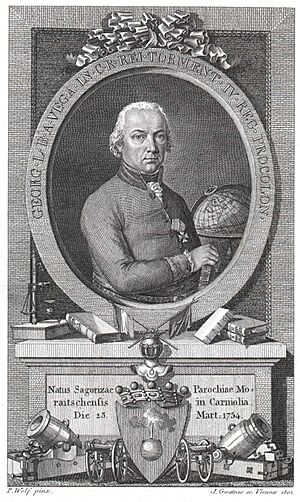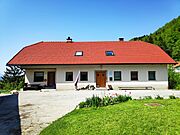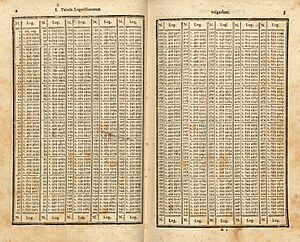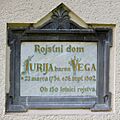Jurij Vega facts for kids
Quick facts for kids
Jurij Vega
|
|
|---|---|

Vega in an 1802 illustration
|
|
| Born |
Jurij Bartolomej Vega
March 23, 1754 Zagorica pri Dolskem, Habsburg monarchy (now Slovenia)
|
| Died | September 26, 1802 (aged 48) Nußdorf near Vienna, Archduchy of Austria
|
| Education | Jesuit College of Ljubljana (Jezuitski kolegij v Ljubljani) (1767–1773) |
| Alma mater | Ljubljana Lyceum (Licej v Ljubljani) (1773–1775; diploma, 1775) |
| Scientific career | |
| Institutions | Academy of Practical Sciences in Mainz |
| Academic advisors | Gabriel Gruber Joseph Giuseppe Jakob von Maffei |
| Notable students | Ignaz Lindner |
Baron Jurij Bartolomej Vega (born Vehovec, March 23, 1754 – September 26, 1802) was a famous Slovene mathematician, physicist, and artillery officer. He is best known for his important work on logarithm tables and for setting a world record in calculating the mathematical constant pi.
Contents
Early life and education
Jurij Vega was born into a farming family in a small village called Zagorica in Slovenia. His father died when Jurij was only six years old.
He went to high school in Ljubljana for six years, from 1767 to 1773. There, he studied many subjects, including Latin, Greek, history, geography, science, and mathematics. About 500 students attended the school at that time.
Vega finished high school when he was 19. After that, he continued his studies at the Lyceum of Ljubljana. In 1775, he became a navigational engineer. This meant he was skilled in using math for navigation.
Military career
Five years after finishing his studies, in 1780, Vega joined the military. He became a professor of mathematics at the Artillery School in Vienna. Around this time, he started using the last name Vega instead of Veha.
When he was 33, Vega married Josefa Svoboda. She was a noble from the Czech Republic.
Vega fought in several wars. In 1788, he helped the Austrian army fight against the Turks at Belgrade. His skill with mortar cannons helped the army capture the Belgrade fortress.
From 1793 to 1797, he fought against French Revolutionary forces. He took part in battles at places like Mannheim and Mainz. In 1795, he helped design new, more powerful mortars. These new cannons could fire much farther than older ones.
In September 1802, Vega was reported missing. A few days later, his body was found. The police said his death was an accident. He is believed to have died on September 26, 1802, near Vienna.
Mathematical achievements
Jurij Vega made huge contributions to mathematics. He published many books of logarithm tables. Logarithms are special mathematical tools that help make complex calculations easier.
His first logarithm book came out in 1783. Later, in 1797, he published another volume with useful formulas. His Handbook, first published in 1793, was translated into many languages and printed over 100 times.
His most important work was Thesaurus Logarithmorum Completus (Treasury of all Logarithms). This book was first published in 1794. It was based on older tables but corrected many errors and added more details for trigonometric functions. Even famous mathematicians like Carl Friedrich Gauss used Vega's tables. Gauss even found a few small errors in Vega's calculations, but Vega's work was still incredibly accurate.
Vega also wrote a four-volume textbook called Vorlesungen über die Mathematik (Lectures about Mathematics). The first volume came out in 1782 when he was 28. These textbooks also contained helpful tables and formulas.
One of Vega's most famous achievements happened on August 20, 1789. He calculated the value of pi (π) to 140 decimal places! The first 126 of these places were correct. This was a world record at the time, and he held it for 52 years until 1841. He even found an error in an earlier calculation of pi by another mathematician.
He used advanced formulas to do this, like:
and checked his answer with another formula:
Even though he worked on topics like ballistics (the study of how things fly) and physics, his main contributions were in mathematics.
In 1781, Vega tried to get the Habsburg monarchy to use the metric system of units. This idea was not accepted at the time, but it was later introduced in 1871.
Vega was a member of several important scientific groups, including:
- The Academy of Practical Sciences in Mainz
- The Physical and Mathematical Society of Erfurt
- The Bohemian Scientific Society in Prague
- The Prussian Academy of Sciences in Berlin
He also received the Order of Maria Theresa award in 1796. In 1800, he was given the title of hereditary baron, which meant he could have his own coat of arms.
Legacy and recognition
Many things have been named in honor of Jurij Vega:
- Jurij Vega High School in Idrija, Slovenia, was founded in 1901.
- In 1935, a crater on the Moon was named after him.
- In 1993, the National Bank of Slovenia put his picture on a 50 tolar banknote.
- In 1994, the Slovene Post Office issued a stamp honoring him.
- In 2004, Slovenia released coins to celebrate his 250th birthday.
- The asteroid 14966 Jurijvega, discovered in 1997, is named after him.
- Slovenia's Vega Astronomical Society is named after him and the star Vega. (The star Vega, however, is much older and not named after him).
- A free computer physics library for simulating 3D objects, Vega FEM, is also named after him.
Scientific teaching
Jurij Vega was also important as a teacher. He was the academic advisor for a student named Ignaz Lindner. This connection is part of a special record of how scientific knowledge is passed down from teachers to students, known as a scientific genealogy.
Images for kids
See also
 In Spanish: Jurij Bartolomej Vega para niños
In Spanish: Jurij Bartolomej Vega para niños








